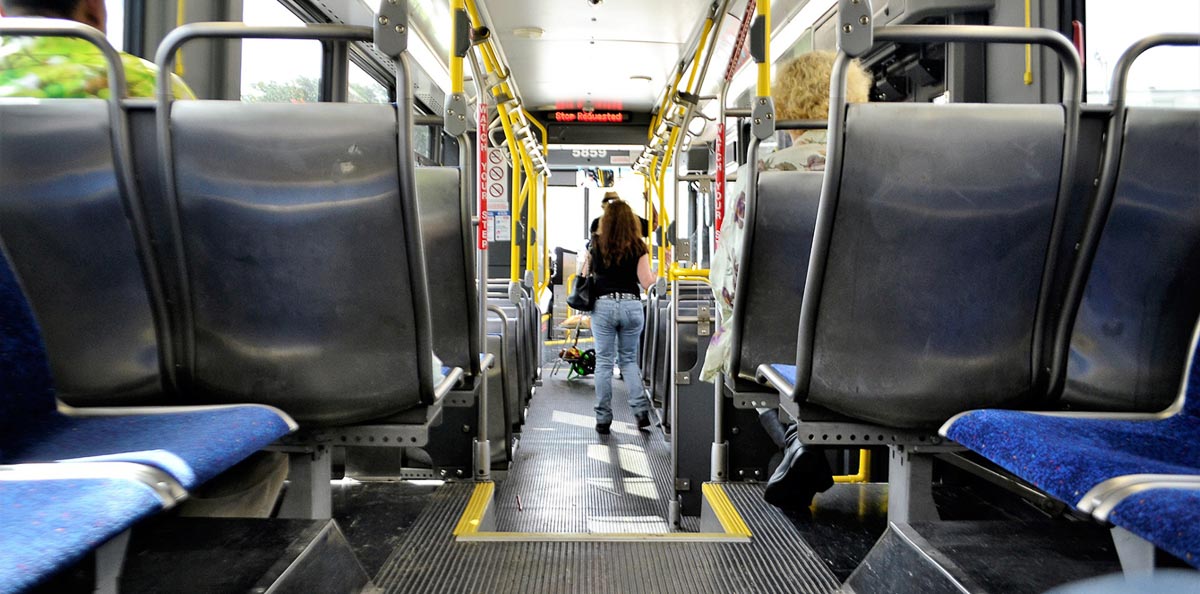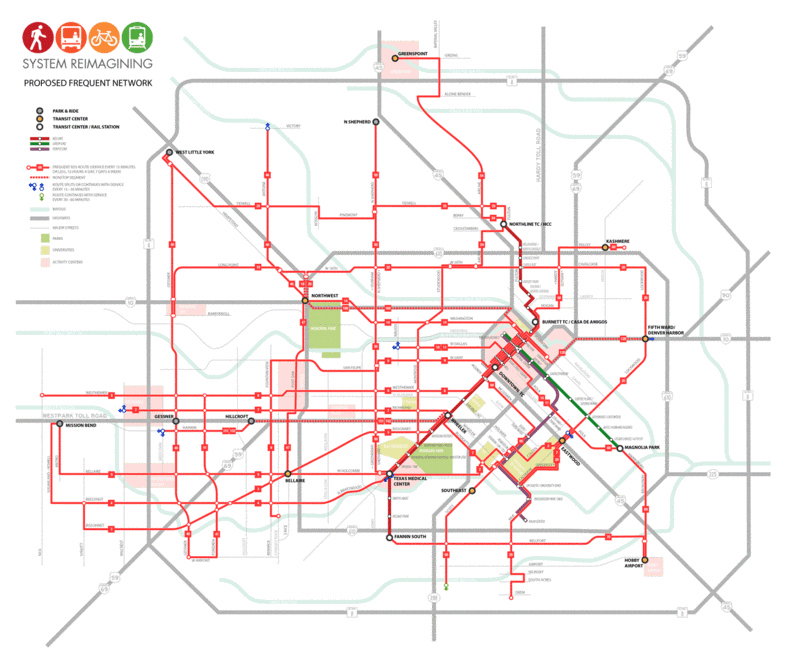Earlier this week, Los Angeles County transportation officials released a plan to increase the frequency of bus service on 29 major routes to every 10 minutes or less — and, in some cases, as often as every five minutes. The plan is a result of a two-year study looking at ways to reverse a 25% decrease in bus ridership on the county’s Metro over the past 10 years. With voter approval, it would be the first update to the county’s bus network in more than 25 years.
Transportation advocates and transit leaders are hoping the $1-billion, five-year capital program will improve bus reliability, speed and comfort. The proposal includes:
► $750 million for bus-only lanes, synchronized traffic signals and other improvements
► $150 million for shelters and other changes at busy stops
Officials estimate ridership could increase by 15% to 20% with the proposed changes.
The plan would steer the region “in the right direction, toward dedicated bus lanes, higher ridership, and faster, more reliable service.,” Los Angeles Mayor Eric Garcetti told the Los Angeles Times. Garcetti is also vice-chair of the Metro board in L.A.
This L.A. story sounds familiar
The circumstances in L.A. are similar to what was happening in Houston a few years ago when a steady decline in ridership prompted Metro to make big changes. The decline was brought on, in part, by an outdated and inefficient wheel-and-spoke bus network with routes — the spokes — feeding into downtown — the hubs.
“But that configuration is problematic,” Kyle Shelton and Kelsey Walker wrote in an August 2015 Urban Edge post. “These days, downtown is hardly the only job center in Harris County. Yet its prominent role in the existing bus network complicates bus trips between other centers of activity around town.
“The new network, in contrast, establishes a grid of efficient, linear bus routes that span our multi-centered metropolitan area.”
At the time, METRO’s New Bus Network completely overhauled the agency’s route system overnight. The redesign was a much better fit for the city Houston had become, providing better service — including expanded weekend service — to more of the population and increased access to the region’s job centers not named downtown. It established a Frequent Network comprising 22 bus routes and the three light rail lines whose stops had 15-minute frequencies, meaning a bus or train would arrive every 15 minutes each day from 5 a.m. to 8 p.m. Routes were simplified and many transfers were eliminated.
Despite a shaky start following the launch, the plan worked.
“Houston in a lot of ways was the trendsetter in this type of redesign, but it’s been happening across the globe in cities looking to update and streamline their bus systems,” says Shelton, who is deputy director of the Kinder Institute for Urban Research. “What most have decided to do is to update routes in ways that eliminate years of ad hoc changes to routes and to rationalize the whole system in ways that bring greater service frequency to the highest ridership routes.”
The New Bus Network's "proposed frequent network" is shown in contrast to the "existing frequent network" here:
Redesign’s success makes it an example for other cities
Officials with Washington D.C.’s Metro are also considering a total transformation of its bus system using the Houston model of scrapping it all and starting from scratch.
“METRO Houston and other agencies that have instituted redesigns have seen growth in ridership, even at a time when other systems are seeing declines,” adds Shelton. “The changes also set up a really solid foundation to add more service and improve transit across the whole system.”
Last fall, voters in Harris County approved the METRONext Moving Forward Plan that eventually will lead to 75 miles of bus rapid transit service, additional and improved HOV lanes, an extension of the light rail to Hobby Airport, and system enhancements such as bus stop improvements, shelters, new or improved transit centers and improvements that address riders’ first mile/last mile commute — before and after using Metro.
The plan gave Metro the green light to borrow up to $3.5 billion for the improvements and doesn’t affect taxes. When completed, it will boost local bus service by 25% and improve reliability and overall access to transit, according to METRO.
Ridership in most major metropolitan areas of the U.S. has been steadily declining in recent years. And transit experts worry about the trend’s impact on cities — economically and socially.
“I think it needs to be considered an emergency,” transit planner Jarrett Walker told the Washington Post. Walker was a consultant on the bus network redesign in Houston. “When we don’t share space efficiently, we get in each other’s way. And that is a problem for the livelihood, the viability, the livability and the economy of a city. … It means more traffic, more congestion.”
Researchers at TransitCenter, a transit advocacy group working to improve transit in cities across the country, point to lower fuel costs, more telecommuting, increased car ownership and the rise of alternatives such as Uber and Lyft as factors driving the dramatic drops in train and bus ridership. And the impact of autonomous vehicles on transit remains to be seen.
But a few cities, including Houston, have bucked the trend and have seen ridership numbers improve since 2014. So, what’s the secret to success?
Steven Higashide — the director of research for TransitCenter — stresses that frequent, fast and reliable public transit is essential to the success of cities, as well as a key driver of equity and environmental sustainability.
National transit expert uses Houston as a case study
In his book “Better Buses, Better Cities: How to Plan, Run, and Win the Fight for Effective Transit,” Higashide examines how transit agencies can raise ridership numbers by increasing the frequency of bus service along busy corridors using METRO’s New Bus Network as an example.
Higashide covers METRO’s 20% decline in ridership between 2007 and 2011, and the concerns transit advocate Christof Spieler raised about the flawed bus system’s inadequacies:
“It was an infrequent system. It was a system which was especially infrequent on the weekends. It was a system which was very confusing to use.”
Eventually, Spieler, an engineer and urban planner, caught the attention of then-Mayor Annise Parker. Parker was keenly interested in Spieler’s perspective because he was promoting the potential of buses at a time when most were pushing light rail. Parker, who considered buses to be the workhorse of the transit system, named Spieler to METRO’s board.
By 2013, Spieler and METRO riders and critics were growing increasingly frustrated with the city’s bus network. For years, Spieler had been calling for the system to be redesigned.
Higashide writes:
It was obvious to Spieler that the bus network had not kept up with the demographics of Houston. Most bus routes went to Houston’s downtown, but they missed several other job centers that had grown over the past two decades. The system had also not responded to the suburbanization of Houston’s poverty, providing little service to neighborhoods that had been middle-income in the 1980s but were now home to many low-income households. This was one reason why transit ridership was falling despite the fact that the transit agency was providing more hours of service than at any point in decades.
METRO takes the 'blank slate' approach
METRO’s board turned to Spieler to lead a strategic planning committee focused on redesigning the bus network. With Spieler in charge, the committee set out to make drastic changes, starting with the search for consultants on the project:
The agency wanted to “design a new regional transit system from the ground up with a ‘blank slate’ approach.” It asked (potential consultants) to consider that the ideal system “might bear absolutely no resemblance to the current system.” It called for someone to help METRO design “a financially sustainable future transit system that will grow ridership while evolving into more than just a transportation system of last resort for those who cannot drive.”
To figure out what it would look like to start over, METRO and its consultants surveyed riders and convened a 120-person stakeholder group.
♦ ♦ ♦
After a lengthy discussion about the tradeoffs between ridership and coverage, METRO’s stakeholders said that the agency should be spending at least three-quarters of its resources on frequent service that would draw ridership. The existing system was about 55 percent ridership routes. Ultimately, the board adopted an official statement saying that 80 percent of its bus service would be dedicated to growing ridership, which would more than double access to frequent transit service for residents, businesses, and low-income households.
♦ ♦ ♦
With the board committed to a bus “re-imagining,” the project team held a week-long design charrette with agency staff to sketch out what the new system would look like. They drew three networks: a “red” frequent network, a “blue” network of routes with 30-minute headways, and “green” hourly buses.
This plan, released in May 2014, undid the old network’s undue focus on downtown, creating a wider grid that sent frequent service into south and west Houston. It would replace the region’s skeletal weekend service with all-day, all-week frequency. It would vastly increase access to transit, putting a million jobs and a million households within reach of frequent transit, with no increase in the operating budget.
You can hear more from Steven Higashide about the important and under-appreciated role of buses in the nation’s transit systems, as well as his take on how to build better buses and bus systems, at the Kinder Institute’s Urban Reads event on Feb. 12.
The writer will sign copies of his book following the discussion.


